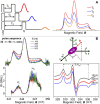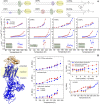Librational Dynamics of Spin-Labeled Membranes at Cryogenic Temperatures From Echo-Detected ED-EPR Spectra
- PMID: 35847982
- PMCID: PMC9277068
- DOI: 10.3389/fmolb.2022.923794
Librational Dynamics of Spin-Labeled Membranes at Cryogenic Temperatures From Echo-Detected ED-EPR Spectra
Abstract
Methods of electron spin echo of pulse electron paramagnetic resonance (EPR) spectroscopy are increasingly employed to investigate biophysical properties of nitroxide-labeled biosystems at cryogenic temperatures. Two-pulse echo-detected ED-spectra have proven to be valuable tools to describe the librational dynamics in the low-temperature phases of both lipids and proteins in membranes. The motional parameter, , given by the product of the mean-square angular amplitude, , and the rotational correlation time, , of the motion, is readily determined from the nitroxide ED-spectra as well as from the W-relaxation rate curves. An independent evaluation of is obtained from the motionally averaged 14N-hyperfine splitting separation in the continuous wave cw-EPR spectra. Finally, the rotational correlation time can be estimated by combining ED- and cw-EPR data. In this mini-review, results on the librational dynamics in model and natural membranes are illustrated.
Keywords: Na, K-ATPase; echo-detected ED-spectra; electron paramagnetic resonance; electron spin echo; librations; model membranes; spin label.
Copyright © 2022 Bartucci and Aloi.
Conflict of interest statement
The authors declare that the research was conducted in the absence of any commercial or financial relationships that could be construed as a potential conflict of interest.
Figures


Similar articles
-
Librational motion of spin-labeled lipids in high-cholesterol containing membranes from echo-detected EPR spectra.Biophys J. 2004 Dec;87(6):3873-81. doi: 10.1529/biophysj.104.046631. Epub 2004 Sep 17. Biophys J. 2004. PMID: 15377533 Free PMC article.
-
Solvent effect on librational dynamics of spin-labelled haemoglobin by ED- and CW-EPR.Eur Biophys J. 2011 Mar;40(3):273-9. doi: 10.1007/s00249-010-0644-5. Epub 2010 Nov 25. Eur Biophys J. 2011. PMID: 21107981
-
Unsaturated lipid bilayers at cryogenic temperature: librational dynamics of chain-labeled lipids from pulsed and CW-EPR.Phys Chem Chem Phys. 2019 Aug 28;21(34):18699-18705. doi: 10.1039/c9cp03318a. Phys Chem Chem Phys. 2019. PMID: 31423504
-
Nitroxide spin labels and EPR spectroscopy: A powerful association for protein dynamics studies.Biochim Biophys Acta Proteins Proteom. 2021 Jul;1869(7):140653. doi: 10.1016/j.bbapap.2021.140653. Epub 2021 Mar 20. Biochim Biophys Acta Proteins Proteom. 2021. PMID: 33757896 Review.
-
Time-resolved electron spin resonance studies of spin-labelled lipids in membranes.Chem Phys Lipids. 2006 Jun;141(1-2):142-57. doi: 10.1016/j.chemphyslip.2006.02.009. Epub 2006 Mar 13. Chem Phys Lipids. 2006. PMID: 16564516 Review.
References
Publication types
LinkOut - more resources
Full Text Sources

